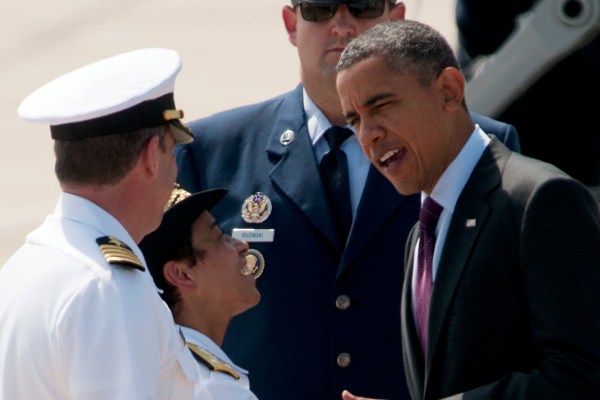Then-Rear Adm. Michelle Howard serving as commander of Expeditionary Strike Group 2 in 2010.
President Obama nominated Vice Admiral Michelle Howard for a fourth star Friday, becoming the first woman in Navy history to attain the rank—assuming Senate approval—of full admiral.
She currently serves as deputy chief of naval operations for operations, plans, and strategy. She has been tapped to serve as vice chief of naval operations, the Navy’s second-ranking officer, and a single step below the chief of naval operations, the service’s top officer.
“Someday, sure, there’ll be a woman CNO,” she presciently told Time nearly 14 years ago, when she was commanding the USS Rushmore, an amphibious dock landing ship, out of San Diego. “It will happen of its own accord.”
Howard steps up during a demanding time for the Navy, trying to pivot to the Pacific amid a funding crunch that has the service scrambling. “The best ambassador,” she likes to say, “is a warship.”
Her promotion comes in the wake of the Army’s decision to tap Ann Dunwoody for four stars in 2008, and the Air Force move to promote Janet Wolfenbarger to its highest rank in 2012. Time interviewed them together last year, shortly before Dunwoody retired.
According to the Pentagon’s latest demographic report, 14.5% of active-duty military personnel are women. They represent 13.5% of the Army, 16.4% of the Navy and 19% of the Air Force. Women account for only 6.8% of the Marine Corps, whose highest-ranking woman achieved three stars before retiring earlier this year.
“Men have the luxury of being average,” Howard said back in that January 2000 interview. “When men walk onto a ship, on board they have the luxury of being average. When you walk in as a woman, that assumption does not come with you—you need to prove yourself.”
Howard said that her command of a ship surprised people more because of her race—she is an African-American—than her gender. “For some of the sailors, it was a big deal—not because of the woman thing, but because of the African-American thing,” she recalled. “I literally had people coming up, wanting to have their picture taken with me—this is the first time this has happened, where a minority woman has had command of a ship.”
Howard, a 1982 graduate of the U.S. Naval Academy, is used to breaking glass ceilings, as she did when she assumed command of the Rushmore in 1999. “Harbor pilots are surprised overseas,” she said at the time. “In Australia, the reaction was tremendous, especially from the women—`Oh good for you, we need to do this in our country!’ The men were: `Well, m’am, we don’t see your type around here.’”
Howard recalled early hostility from some in the Navy, believing she was shunted away from favored assignments that went to men she felt were less qualified. But that began to change. “What’s great about the Navy is that despite the few knuckleheads that exist,” she said, “there are a lot of folks who are professional, and who will grade you on your performance and not on how you look.”

Vice Adm. Michelle Howard greets President Obama at Norfolk Navy base in 2012.
She recalls the comments when she took an officer’s billet on a warship with a woman also serving as second-in-command. “I was not prepared for the focus on it—`My God, there’s a warship with two women in the top positions—it’s going to sink just from their presence.’ It was hilarious.”
In that interview on the bridge of the Rushmore in San Diego harbor, Howard said she was happy to be in command in the Navy rather than the Army. “It’s good to be a captain of a ship and not the colonel of a squadron,” she said. “I spent 1998 with the Army at the Command and General Staff College [at Fort Leavenworth, Kan.], and we talked a lot about how there is nothing else in the military like being the CO of a ship. You are out there on your own with your little city of folks, and the Navy provides us with a lot of management leeway that I don’t see in the other services. That’s driven by the demands of sea-going lifestyles—you need to have that level of control in order to maintain good order and discipline.”
She was asked whether it was tougher dealing with sexism or racism in the service. “Sexism within the service, and racism outside the service,” she responded. “Maybe that’s because we started to integrate the officer corps starting at the end of World War II, as far as race was concerned.”
Howard noted that she had come in for her share of ribbing as commander of the Rushmore at 39 (she’s 53 now). “There is one guy on board who refers to me as `Grandma,’” she said, “rather than the `Old Man.’”

